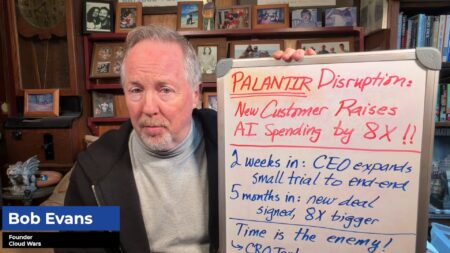
Continuing to post eye-popping growth rates in spite of the global economic slowdown, Workday (23%), Salesforce (22%), and Snowflake (83%) demonstrated yet again that CEOs are embracing modern cloud technology as indispensable in optimizing today’s operations and creating tomorrow’s opportunities.
The leaders of each of those three Cloud Wars Top 10 companies openly acknowledged that deals are taking longer to close and undergoing greater levels of scrutiny. But they also said that business customers are nevertheless greenlighting major investments in cloud solutions for HCM and financials (Workday), CRM (Salesforce), and data clouds (Snowflake).
For the fiscal second quarter ending July 31, the growth rates for each of those three cloud heavyweights hammered home unequivocally the status the cloud has gained as existentially essential:
- Workday subscription revenue up 23% to $1.37 billion;
- Salesforce revenue up 22% to $7.72 billion; and
- Snowflake product revenue up 83% to $466 million.
Workday
The company’s rising trend in revenue growth — this is its fifth straight quarter of accelerating growth — was matched by an impressive performance in future revenue potential as well.
On the August 25th earnings call, CFO Barbara Larson said that as of July 31, the total subscription revenue backlog was up 27% to $13.47 billion.
Co-CEO Aneel Bhusri kicked off his opening remarks by pointing out the overall strength of the company’s entire product lineup “across all product areas and geography.”
In addition, Bhusri said, Workday “outperformed across our key operating metrics” because of the “continued importance of digital transformation for finance and HR.”
That up-close involvement as companies create their digital futures, Bhusri said, has enabled Workday to once again boost its growth rate in spite of what he called “the uncertainty in this environment.”
“We remain confident in our long-term growth prospects because Workday continues to serve as a mission-critical partner to our customers with a proven track record of success,” he said.
Salesforce
For Marc Benioff’s company, its very strong fiscal Q2 served as what he called a “milestone” and that I will call a momentous achievement: as we wrote about yesterday, for the first time ever, Salesforce leapfrogged SAP in quarterly revenue as Salesforce’s Q2 revenue of $7.72 billion eclipsed SAP’s total Q2 revenue of $7.52 billion.
On top of that, reporting from its latest quarter, Salesforce’s business looks strong into the future as its remaining performance obligation (RPO) now totals a whopping $41.6 billion.
Benioff said that over the last few months as he’s “met with hundreds of CEOs with economists, business leaders, political leaders, and other experts about their business and where they see this global economy heading,” the consensus is “that digital transformation remains the number one priority for CEOs and that every digital transformation begins and ends with the customer. That’s what continues to drive our business forward.”
Snowflake
Last quarter, Snowflake reported product-revenue growth of 84%, which led me to predict that its growth rate for the just-ended quarter would be 75%. Giving my goofy prediction the back of its hand, Snowflake posted an actual product-revenue growth rate of 83%, generating fiscal-Q2 revenue of $466 million.
As with Workday and Salesforce, Snowflake also reported a big jump in RPO: up 78% year over year to $2.7 billion, with a net-revenue retention rate of 170%.
CEO Frank Slootman said, “Snowflake gets prioritized fairly high inside the enterprise” because it sits “right on the intersection of cloud computing, artificial intelligence, machine learning, and advanced analytics.”
At that junction, he said, customers are “picking up the scent of the opportunity that is in front of them. And they’re investing — they’re hiring and they’re buying because these are things that are going to be big changes for the industry. Whole industries are going to get redefined in healthcare, in pharma, and financial services,” Slootman said.
Such an environment is, Slootman said, the ideal environment for the cloud.
“So this is not ‘business as usual and let’s hit the brakes’. Instead, there is a very, very high urgency around advancing toward cloud-computing environments and having an opportunity to really pursue the promise that it brings.
“We’re looking at very, very exciting times where things are becoming possible that we couldn’t even dream of just a few short years ago,” an opportunity that is creating an unprecedented attitude toward IT investments.
“So, this is why we feel that this is not one of those expenses that people are going to casually cut back on — because it’s strategically compelling and important.”
Final Thoughts
So, we’ll see what happens in the rest of the year, but for the quarter ended July 31, Workday has rocked, Salesforce has kept on rolling, and Snowflake is romping at a rate that few companies its size have ever experienced. As we predicted a week or so ago, those three cloud powerhouses have combined to tell the recession to go pound sand.
And the cloud — the greatest growth market the world has ever known — continues to prove it is utterly indispensable to the digital futures of businesses in every industry.
Want to gain more insights from Bob Evans and view cloud-focused content from Cloud Wars Expo? On-demand video from the event is rolling out now, with more than 40 hours of cloud education content — featuring 100-plus speakers — to be made available in the coming days. All content is free to Acceleration Economy subscribers with an on-demand pass.









